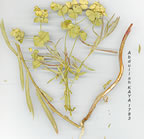| Euphorbiaceae |
 Euphorbia virgata |
 Euphorbia virgata |
| Euphorbia L. Euphorbia virgata WALDST. ET KIT. Ömür: Çok yıllık Yapı: ot Hayat formu: İlk çiçeklenme zamanı: 4 Son çiçeklenme zamanı: 9 Habitat: Quercus ormanı ve çalılığı, step, otlak alan, kayalık yamaç, sukenarı, bataklık Minimum yükseklik: 1000 Maksimum yükseklik: 3000 Endemik: - Element: ? Türkiye dağılımı: K., G., D. ve bitişiği komşu O. Anadolu Genel dağılımı: Fransa'dan O. Avrupa'ya, K. Balkanlardan Sibirya ve Pakistan’a Bulunduğu kareler:A4 A5 A6 A7 A8 A9 B6 B7 B8 B9 B10 C4 C9 C10 |
| E. virgata Waldst. & Kit., Pl. Rar. Hung. 2:176, t. 162 (1804) non Desf. (1804). Syn: E. uralensis Fischer ex Link, Enum. Hort. Berol. Alt. 2:14 (1822); E. tommasiniana Bertol., Fl. Ital. 5:78 (1842)! E. virgata Waldst. & Kit. var. orientalis Boiss. in DC, Prodr. 15(2): 160 (1862)! E. boissieriana (Woronow) Prokh. in Fl. URSS 14:445 (1949)! Ic: Fiori, Ic. Fl. Ital. f.2615 (1901); Hegi, I11. Fl. Mittel-Eur. 5(1): t. 1782, 1783 (1925). Glabrous perennial. Stems several, to 1 m, arising from a woody stock; axillary shoots to 13, arising near middle of stem. Caulirte leaves linear to linear-lanceolate, 1.5-10(-12) x 0.1-l(-1.5) cm, acute or obtuse, entire; leaves of axillary shoots narrower. Ray-leaves linear-lanceolate to ovate. Raylet-leaves ovate-rhombic, ovate-deltoid or reniform,.5-15(-l8) x 5-20 mm, apex acute to obtuse, mucronate, base cuneate, rounded, truncate or shallow-ly cordate. Rays 6-15(-30), once or twice dichotomous; axillary rays 2-20 (-35). Glands medium- to long-horned. Fruit deeply trilobate, 4-5 mm diam., granulate. Seeds ovoid, 2 mm, smooth, grey, caruncle small. Fl. 4-9. Quercus forest and scrub, steppe, grassland, rocky slopes, streamsides, marshes, ditches, fields, roadsides, 1000-3000 m. Type: [Hungary, N. Jugoslavia] si altiora loca montosa demas, per omnem fere Hungariam, Croatiam et Sclavoniam locis siccis, Waldstein (holo. PR, photo E!). N., S., E. & adjacent C. Anatolia. A4 Kastamonu: above Küre, 1220 m, D. 21635! A5 Kastamonu: Tosya, Sint. 1892:4890! A6 Sivas: Sariyar, N.E. of Çirçir, 1500-1700 m, Sorger 69-57-15! A7 Gümüşane: Gümüşane, Bourgeau 143! A8 Erzurum: 75 km N. of Erzurum, 2400 m, Walton 19! A9 Kars: 10 km from Sarikamiş to Karakurt, 2050 m, D. 46508! B6 Sivas: Zara to Sivas, 1500 m, Stn. & Hend. 5320! B7 Tunceli: Pülümür to Selepur, 1850 m, D. 31582! B8 Erzurum: 10 km N. of Hinis, 1630 m, D. 46237! B9 Bitlis: Nemrut Da., 3000 m, Tong 144! B10 Kars: N.E. slope of Ağri Da., below Serdar Bulak, 1900 m, D. 43798! C4 Içel: 40 km from Mut to Kirobasi, Cümelek, 1100 m, Hub.-Mor. 9961. C10 Hakkari: Yüksekova, 1950 m, Duncan & Tait 184! From France eastwards through C. Europe and the N. Balkans to Siberia and Pakistan. Narrowly linear-leaved plants have been referred to E. uralensis Fischer ex Link, and robust lanceolate-leaved plants to E. boissieriana (Woronow) Prokh., but these 'species' merely represent extreme states in the ± continuous variation of E. virgata. In Europe, E. virgata merges with E. esula L., and has been regarded there as a subspecies of the latter. Huet du Pavilion's record of E. esula from Erzurum, cited by Tchihatcheff (Asie Min. Bot. 1:163, 1860), is undoubtedly referable to E. virgata. |